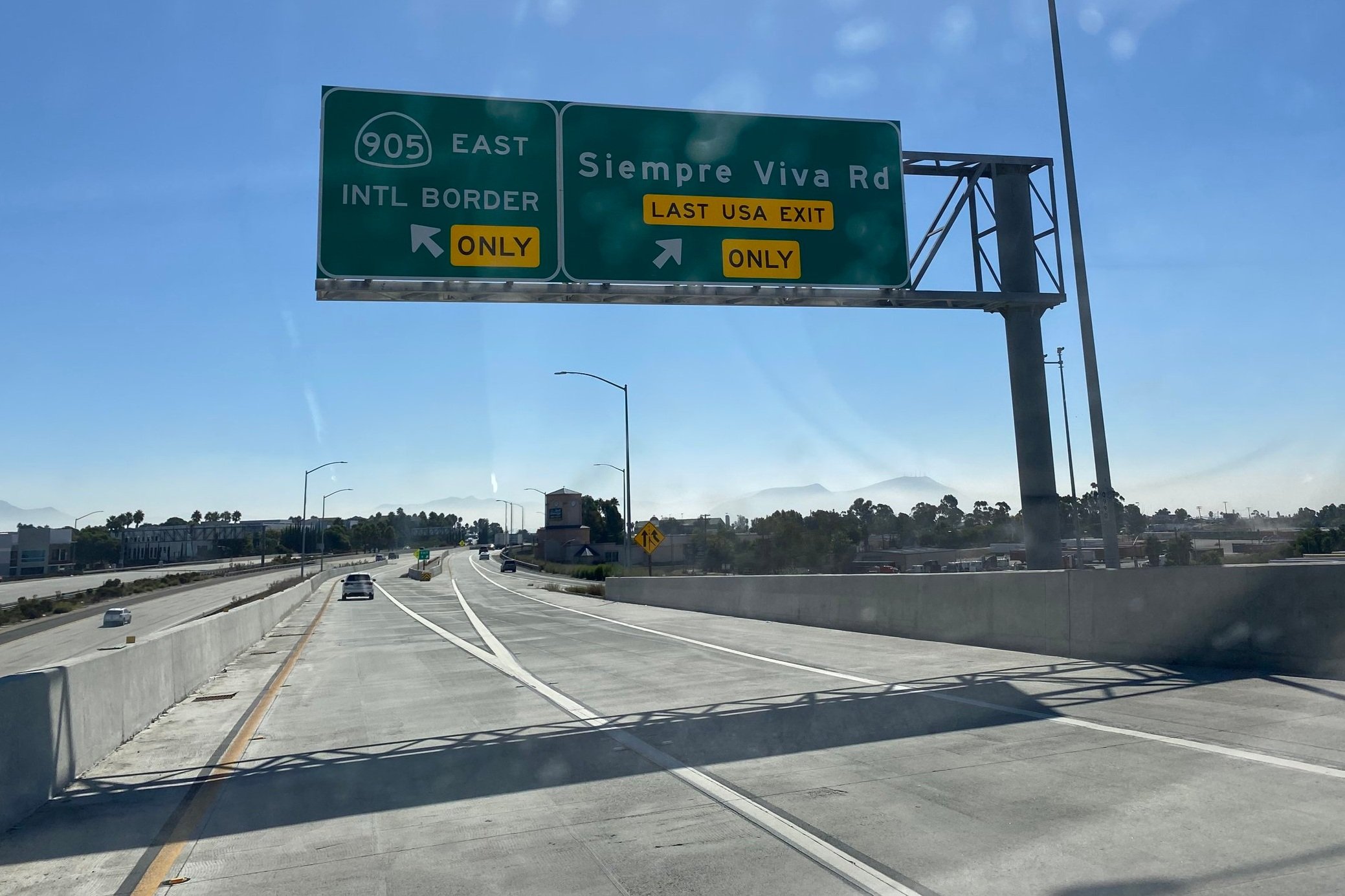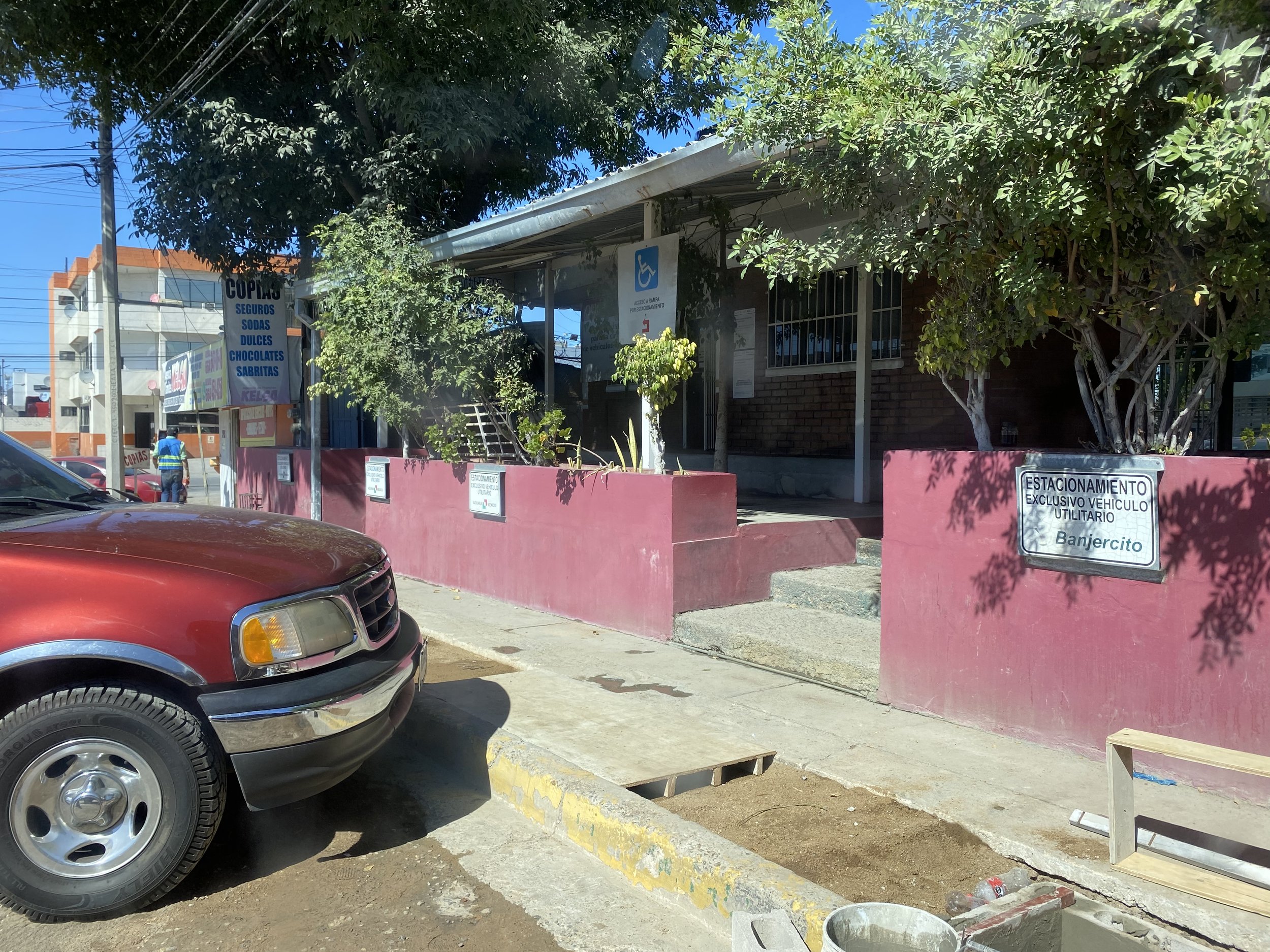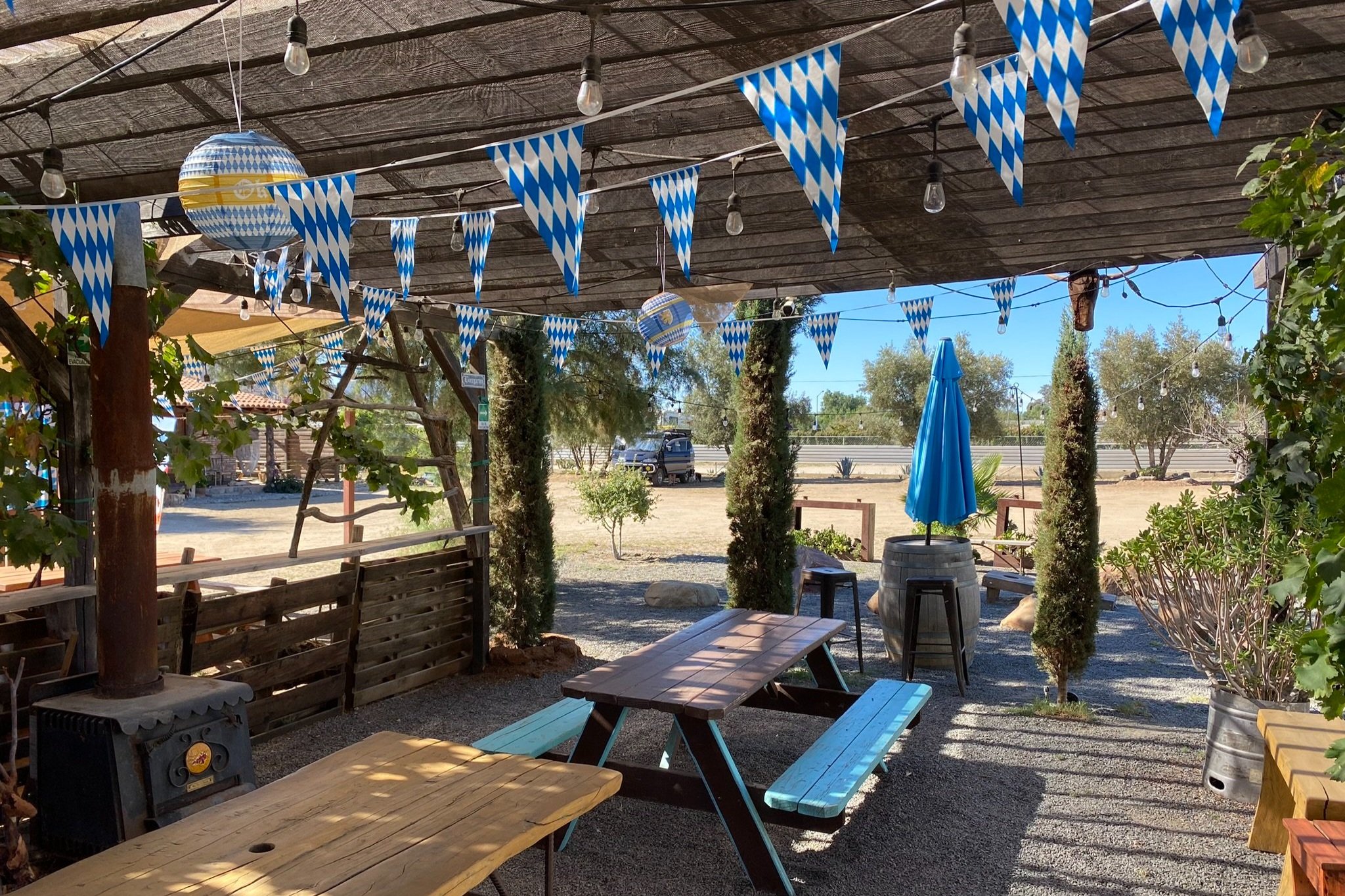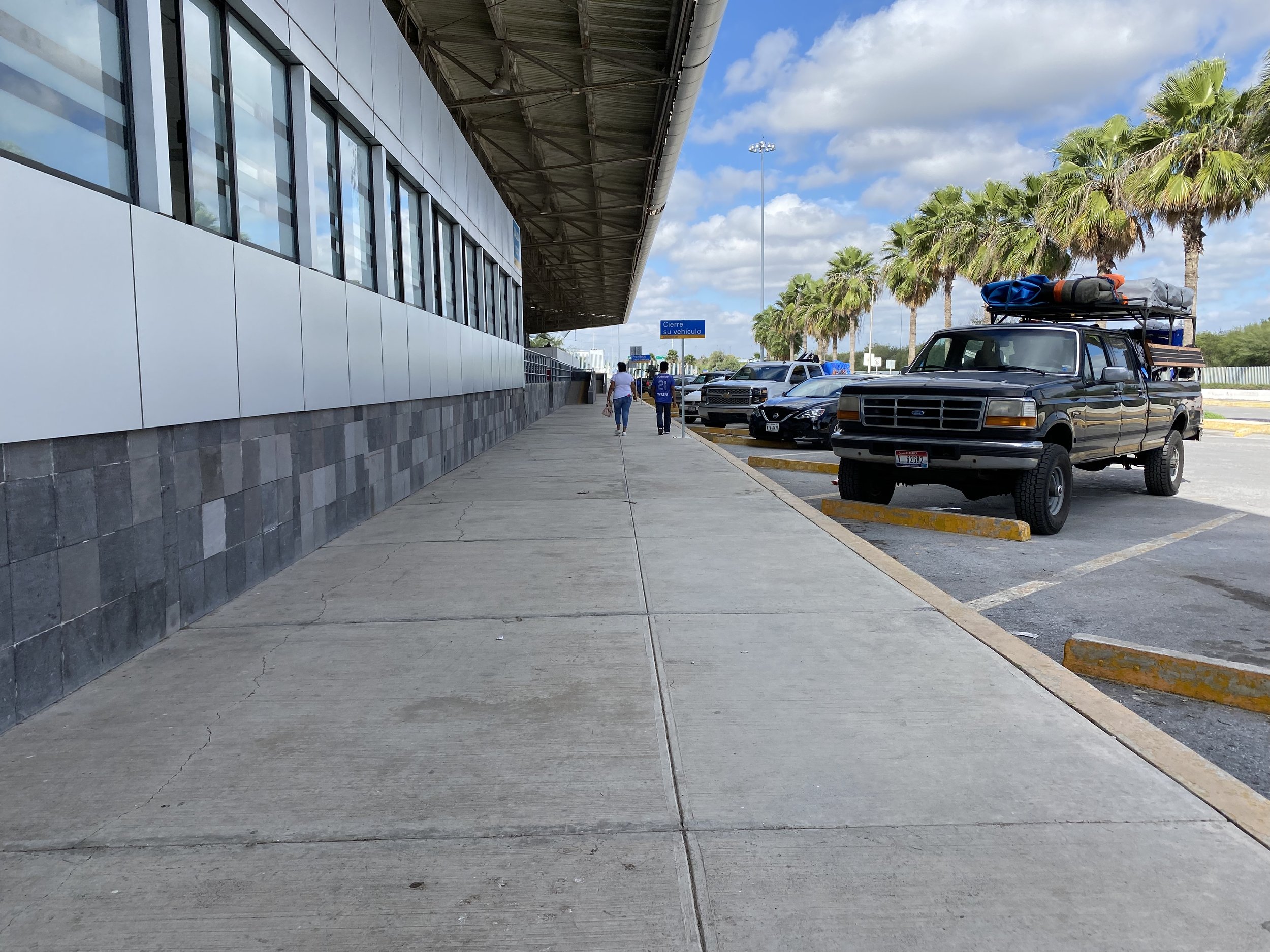Oct 14 - Oct 15 : The Three-Hour Tour: Crisscrossing the Border
/We’ve honestly never felt more prepared for a trip than we have on this one. We spent months getting the van fitted out comfortably, we spent weeks tidying up the house and getting the property presentable for a renter, and we spent all yesterday preparing to cross the Mexican border. Repairs were made, laundry was washed, paper work printed and copied, insurance purchased and issued. We had learned from the past two grand adventures that you need to have your ducks in a row before you leave the US, so we did just that. We remembered to empty our spare fuel cans into the gas tank, as Mexico doesn’t want you traveling across the border with excess foreign fuel. We built a handy pouch of copied documents and hid the originals deep in bowels of Walter, the Delica L400, in case a checkpoint needed to see our papers. We built false wallets including voided IDs and low-balance credit cards, in case we were pickpocketed. The one thing we didn’t do, or at least didn’t do well enough, was look where we going.
The morning of October 14th, 2023, was gorgeous. Our “camp spot” in San Diego was socked in with fog that burnt away early, giving way to a 9:30 AM solar eclipse that dappled our friends’ driveway with a million little crescent suns. We were up earlier than that though, having what we thought was one last family breakfast of eggs and homemade bacon, and finishing our packing. After big goodbyes to our hosts and the kids, we loaded up into the van and nervously laughed all the way to the border. Surface crossings are the best, at least for a New Englander turned Idahoan like myself - its just not a thing that we did or do. As a child, international crossings were done by plane, and there were few dramas past filling out the immigration cards when we traveled like that, but surface crossings are a different animal. They are partially chaotic, partially organized in a system that a newcomer doesn’t understand. They fill me with nervousness and glee - honestly, it feels a lot like dropping into a big rapid, especially a big rapid on a pool-drop river. Slow calmness and apprehension, followed by hasty action and chaos in an alien space, then back to calmness, reflection, and sometimes wound-licking, and most times thankful prayer.
We were giddy on the drive, going over our checklists, our plans for after the crossing, the location of the Banjercito for paying the TIP (Temporary Import Permit) fee, our possible camp spots, our back up camp spots, even our likely menu for that night’s dinner. The fifteen or so miles melted away instantly, and with almost no warning we were passing big signs painted on the free way reading “LAST US EXIT” in one lane and “MEXICO” in another. Moments later, we pointed out the near hypocrisy of those words as we passed another sign offering a U-turn to the USA through the median - the last chance was really a second-to-last chance. We drove onward, toward a new border crossing, triumphant in our nearly 1500 mile journey to the border.
We made it through the red-light-green-light of the actual border, and then were instantly flagged into secondary. The customs official was incredibly nice, genuinely happy to see us there, and asked to have me open the rear hatch and the slider. I told him we had a dog and he said it was ok, and then upon opening the hatch he honestly cooed at Gracie, as if he wouldn’t mind playing fetch with her, but thought that the Mexican Marine standing at his station might think otherwise. He asked us where we were going, we said “Veracruz” and his face lit up, understanding the distance of the drive ahead of us, and delighted that we were going to go and see and enjoy his beautiful country. We asked him for directions to the Banjercito to get our TIP and FFM tourist cards, showing him the map we had, and he confirmed that we were headed to the correct location, only two right turns away, less than a city block. He wished us well, and we sped off, straight past the immigration and declaration lanes, and out into the busy streets of east Tijuana.
Upon arriving at the Banjercito, a little frazzled from the workup to the border and the quarter mile drive from the inspection lane to the parking lot, we got our affairs in order and came up with a plan - I would take my passport and the vehicle title into the office, get my FFM tourist card and the TIP for Walter, while Chelsea would wait with the dog. Then Chelsea would head in, get her FFM and we would drive off into the sunset to camp in the Valle de Guadalupe. Everything went swimmingly - the guard at the door was very nice, and a sweet bilingual woman waiting for her husband to exit the office translated for me. She explained to the guard what I needed, I was let into the otherwise empty office, and the gentleman behind the desk was nearly fluent in English. He looked over my registration and title, said everything was good, and then asked for my FFM card. I informed him that I would need one, and then my wife would come in for one. He informed me that I could not get an FFM at this office, and the only place to get a tourist card was back in the border, before we entered Mexico. We needed to be processed in upon entry, at the place of entry, at the immigration and declaration lane that we had just whizzed past. Cool.
Feeling a little panic welling up inside me, and making the moderately staid and sexist joke of “Boy, is my wife going to be mad at me!”, I asked him if I could drive back to the immigration office. His face betrayed his emotion, and although his words were “I don’t think so,” his face said “Absolutely not.” I asked if I could walk back to the immigration office, and he shrugged, giving me an honest “Maybe.” That was all I needed. After putting our heads together, Chelsea and I decided to park around the corner in a paid lot, and I would take the papers for myself and the van, and try to make it back into the immigration office. If I was successful, I would tell the officers to expect my wife, and then swap spots with Chelsea. We just didn’t want to leave the van and the dog alone, it didn’t seem prudent, and Chelsea didn’t need any more exploratory walking, her injured back was happy enough to stay seated in Walter’s plush seats.
I set out on foot, very concerned that I was not going to be able to find a route back through the one-way turnstiles and into the border zone, and more concerned that if I did find a route, Chelsea would have to walk it alone and with her back sending pins and needles and pain down her right leg, and even more concerned that if I did make it, and Chelsea made it, that the immigration officers would want to inspect our 26 year-old, right-hand-drive, kinda-converted-but-sir-I-swear-it’s-a-car-and-not-an-RV minivan parked outside the border area in a paid lot. I felt like I had at least three hoops to jump through, and that was maybe two hoops too many, and maybe I was getting too old to be a traveler.
I approached the turnstiles at the exit of the Border area, their spinning bars denoting where the stark white federal zone abuts the colorful world of Mexico, where the formal bleeds away into the practical. Unfortunately, I was like a fish swimming upstream, and I was going to have to try to make the formal world work for me. In my best broken Spanish I asked for the immigration office, and then explained I needed an FFM and a TIP. The guard was confused, but understood I wanted to go back to the immigration offices. He denied me, I pled my case, he made a radio call to a superior that was seated 20 feet away, and then we walked those 20 feet, to talk to the older, more official, and less pleased supervisor. The guard pled my case, we were both met with a “No,” to which I asked again for a favor, and I was met with a larger, more succinct “NO.”
The guard took pity on me, he could tell I was a little lost, which coincidentally was a product of getting a little lost in the first place. He walked me over to the concrete barrier that separated the pedestrian outlet from the auto lanes, and the fence beyond those lanes that separated the trickle of Mexican traffic from the torrent of American-bound vehicles, and he gestured around the fences, and back northward toward the immigration office. I didn’t really understand what he was saying, but I thought he might mean I could just hop the barrier and walk back up the road to the immigration office. The rule follower in me balked at the idea, the wannabe adventurer was considering it, but in the back of my mind I couldn’t escape the idea of Chelsea having to do whatever it was I did; if I got my FFM and TIP, she would need her FFM, and I didn’t want her hopping a jersey barrier and walking against the flow of traffic, not with her back the way it was.
I silently considered what I thought the guard was recommending, and then I walked over to a taxi stand where a few drivers were resting in the afternoon shade, waiting for fares. After offering my usual “Sorry my Spanish is so bad” introduction, I explained my situation and what I thought the guard was telling me to do, and the drivers cleared up all my confusion: I certainly could not hop the barrier and walk back up the one-way traffic to the immigration office. The guard was telling me to get in the pedestrian border line for the US, walk through the border, and then re-enter Mexico, and that the vehicle crossing back into the US would take maybe four hours, but that I should just leave my van here and do it on foot…it would take maybe an hour.
I contemplated this as I walked back to Chelsea, the van and the dog. We could just walk up and around, through the border and back through the border. It was barely past noon, maybe we could be back under way by 2PM and headed to the warm embrace of the Valle de Guadalupe by late afternoon. But I didn’t want to leave Walter unattended, even in a paid parking lot, it just didn’t fit with how Chelsea and I manage our risks. We would have to leave most of our belongings unattended, not to mention our mobile home, our shelter on the road, and that was a die we didn’t want to cast.
After a severe bout of mental self-flagellation, Chelsea and I decided there was really only one thing to do: get back into the border line to cross into the states, with the entire family intact. The alternative plans all had their flaws, some real and some likely perceived. Walking across the border would have been difficult on Chelsea and the dog, and would have left the van in limbo. Seeking out a more accessible immigration office would have been possible, but we had few details on how to go about doing it. Camping without papers in the Valle de Guadalupe would have been completely legal, but it would have kicked the can down the road for another day and that didn’t seem worth it. Defeated and deflated, we drove around the surface streets of east Tijuana, looking for the tail end of the snake of cars and trucks slowly inching towards the US.
We had initially crossed the border at 11AM, and we were back in the border line by noon, the frantic running around having only taken an hour. The drivers at the taxi stand had guessed that the current wait was four hours, but the actual distance we had to cover was pretty short, and the automotive snake was inching forward, slowly but surely. We cycled the A/C on and off, not wanting to overwork or overheat any one system on the Delica as we crept by dozens of carts selling everything from pastries to coconuts to 24 inch tall plaster models of such famous figures as Popocatépetl, Jesus Christ, and the Predator. Everything you could ever want can be found in the border line.
During the wait, Chelsea and I were contemplating what the move would be after we had returned to the US side. We did some Googling and found the most direct route back to the southbound lanes, and then did some math and tried to establish a pumpkin hour for this little misadventure. It was tough telling not knowing how long a successful trip through immigration could last - if we crossed at 2:30PM, and rendered Mexico by 3:00PM, and were out of immigration by 4:00PM, could we make it to the Valle de Guadeloupe by sundown at 6:00PM? We could if it all went well, but we wouldn’t be leaving ourselves any time for hiccups, breakdowns, malfunctions or failures. On one hand, we really wanted to be in Mexico, we really wanted to start the trip, but on the other hand we had learned so many times not to push the envelope with time and daylight, because that kind of decision making only leads to haste and danger. Driving with fading daylight makes you want to get to your destination sooner, and next thing you know you are speeding just a little in the twilight and then BAM, you hit an unmarked tope (Mexico’s infamous and unforgiving speed bumps) and you destroy your front suspension or pop a tire. Bad decisions tend to cascade, and we had finally reached a point in our lives where we were strong enough to put aside our immediate desires in favor of safety now and success tomorrow.
We made it to the US border at exactly 2:00PM. We know this because we got to watch a ten minute changing-of-the-guard that halted all forward progress and felt like it took forever. The officer that processed us back into the US looked at us quizzically, not fully understanding why we only spent three hours in Mexico, and two of those three in the border line, but she didn’t want any more details and waved us through. It was still early, the border behind us was still tugging at our shirttails, begging us to come play, but we had made our decision, and secured one last night of camping in our friend’s driveway, so we drove back to the known, leaving the unknown for tomorrow.
In the end, we were happy with our choices, and it felt like opening a new chapter in our book of adventures, not only because we had dipped our toes into the pool of the next leg of the trip, not only because one little misadventure had proven to us that the drive to the border was worth it, but because we had made choices as a team that we probably wouldn’t have made in the past. We had said no to the impulse to push the limit, we had said no to the sprint and the unsafe driving, we delayed gratification in favor of the possibility of a longer, better, slower trip. We were getting older, and a younger us might have done something different, and gotten a very different outcome.
It was the last exit, but not the last chance to turn around. If you haven’t done a surface crossing before, beware: if you make it to the border, they will make you cross.
The Banjercito…where we were first informed of our missed turn.
Panic fading to regret fading to complacemt discomfort as I realized that we had missed our chance to get our papers and penance would be paid for in plummeting MPGs and skyrocketing temps.
We spied a “baja Rally” sticker, the Motorcycle race created and produced by our Ensenadan friend Mauricio, mocking us on the signage leading us back to the US border.
Everything you could ever want can be found in a border line.
Mexico bound on the left, US bound on the right.
If you’re in the border line, you have to get churros. It’s a rule.
We had one last “one last” family dinner with our friends, and the next morning we had one last “one last” family breakfast, and then another final big send-off. Our second attempt at crossing was remarkably smooth - there wasn’t a single other vehicle at immigration when we arrived, and we were processed quickly and got our FFM cards without issue. Getting our TIP was easy until the officer had to enter our VIN into the computer, as our van’s Japanese heritage means its serial number is only eleven digits instead of the standard seventeen. It took a few phone calls, but she eventually sorted it out and we were on our way, finally leaving the border in our rear view mirror, its stark white walls fading into the background, a white speck in the Mexican mass of technicolor excellence.
We made a hard left out of East Tijuana and followed the highway just south of the border wall towards Tecate, veering off when we saw signs for the Valle de Guadalupe. Finally, we were making miles and making time, diving deep enough into Baja to feel committed, out of the range of the tractor beam to the US border. An hour passed by and we got peckish, so we stopped for instant coffee and homemade chilaquiles, a second breakfast at little truck stop restaurant. We continued on into the early afternoon, into the Valle, sliding in to what felt like home base, even though we knew we were barely out of the dugout, not even at bat yet on this trip, We had been to the Valle six years earlier, and it looked exactly as expected on our return: moderately more developed, but still dusty and beautiful and full of vineyards. We stopped for a wine tasting at one of the vineyards, because when in Rome, you should drink wine. Then we made it to Bellinghausen Brewery, a little craft cerveceria, our target for the night. We found what we were looking for, a free parking spot with a bathroom and a locked gate. We were home on the road again.
The next attempt…we were the only vehicle processing through Immigration.
Our fist-bump of celebration after we did all the right things the second time around.
Following the border wall on the southern side. (That large red-iron looking thing is the border wall)
Second breakfast, first meal in Mexico, homemade chilaquiles and instant coffee served under arctic air conditioning.
Touring the vineyards of the Valle de Guadeloupe.
Wine tasting at BAjA’s largest winery.
Home for night one at Bellinghuasen Brewery.































